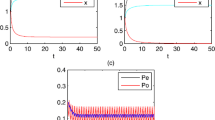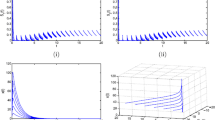Abstract
In this paper, we consider the global behaviors of Monod type chemostat model with nutrient recycling and impulsive input. By introducing a new study method, the sufficient and necessary conditions on the permanence and extinction of the microorganisms are obtained. Furthermore, by using the Liapunov function method, the sufficient condition on the global attractivity of the system is established. Lastly, an example is given, the numerical simulation shows that if only the system is permanent, then it also is globally attractive.
Similar content being viewed by others
References
Beretta E., Takeuchi Y.: Global stability for chemostat equations with delayed nutrient recycling. Nonlinear World 1, 191–306 (1994)
Bulter G.J., Hsu S.B., Waltman P.: A mathematical model of the chemostat with periodic washout rate. SIAM J. Appl. Math. 45, 435–449 (1985)
Freedman H.I., Xu Y.: Models of competition in the chemostat with instantaneous and delayed nutrient recycling. J. Math. Biol. 31, 513–527 (1993)
Hale J.K., Somolinas A.S.: Competition for fluctuating nutrient. J. Math. Biol. 18, 255–280 (1983)
He X., Ruan S., Xia H.: Global stability in chemostat-type equatinos with distributed delays. SIAM J. Math. Anal. 29, 681–696 (1998)
He X., Ruan S.: Global stability in chemostat-type plankton models with delayed nutrient recycling. J. Math. Biol. 37, 253–271 (1998)
Jang S.: Dynamics of variable-yield nutrient-phytoplankton-zooplankton models with nutient recycling and self-shading. J. Math. Biol. 40, 229–250 (2000)
Jiao J., Chen L.: Dynamical analysis of a chemostat model with delayed response in growth and pulse input in polluted environment. J. Math. Chem. 46, 502–513 (2009) doi:10.1007/s10910-008-9474-4
Meng X., Zhao Q., Chen L.: Global qualitative analysis of new Monod type chemostat model with delayed growth response and pulsed input in polluted environment. Appl. Math. Mech. 29, 75–87 (2008)
Pang G., Liang Y., Wang F.: Analysis of Monod type food chain chemostat with k-times periodically pulsed input. J. Math. Chem. 43, 1371–1388 (2008)
Pilyugin S., Waltman P.: Competition in the unstirred chemostat with periodic input and washout. SIAM J. Appl. Math. 59, 1157–1177 (1999)
Ruan S.: Persistence and coexistence in zooplankton-phytoplankton-nutrient models with instantaneous nutrient recycling. J. Math. Biol. 31, 633–654 (1993)
Ruan S.: A three-trophic-level model of plankton dynamics with nutrient recycling. Canad. Appl. Math. Quart. 1, 529–553 (1993)
Ruan S.: The effect of delays on stability and persistence in plankton models. Nonlinear Anal. 24, 575–585 (1995)
Ruan S., He X.: Global stability in chemostat-type competition models with nutrient recycling. SIAM J. Appl. Math. 58, 170–192 (1998)
Smith H.L.: Competitive coexistence in an oscillating chemostat chemostat. SIAM J. Appl. Math. 40, 498–522 (1981)
Simth H.L., Waltman P.: The theory of the chemostat. Cambrige University Press, Cambridge (1995)
Sree Hari Rao V., Raja Sekhara Rao P.: Global stability in chemostat models involving time delays and wall growth. Nonlinear Anal RWA 5, 141–158 (2004)
Sun S., Chen L., Sun S.: Dynamic behaviors of Monod type chemostat model with impulsive perturbation on the nutrient concentration. J. Math. Chem. 42, 837–847 (2007)
Wang F., Hao C., Chen L.: Bifurcation and chaos in a Tessiet type food chain chemostat with pulsed input and washout. Chaos Solitons Fractals 32, 1547–1561 (2007)
Wang F., Pang G.: Competition in a chemostat with Beddington-DEAngelis growth rates and periodic pulsed nutrient. J. Math. Chem. 44, 691–710 (2008)
Wang F., Pang G., Chen L.: Study of a Monod-Haldene type food chain chemostat with pulsed substrate. J. Math. Chem. 43, 210–226 (2008)
Xiang Z., Song X.: A model of competition between plasmid-bearing and plasmid-free organisms in a chemostat with periodic input. Chaos Solitons Fractals 32, 1419–1428 (2007)
Zhang S., Tan D.: Study of a chemostat model with Beddington-DeAngelis functional response and pulsed input and washout at different times. J. Math. Chem. 44, 217–227 (2008)
Zhao Z., Chen L., Song X.: Extinction and permanence of chemostat model with pulsed input in a polluted environment. Commun. Nonlinear Sci. Numer. Simul. 14, 1737–1745 (2009)
Zhou X., Song X., Shi X.: Analysis of competitive chemostat models with the Beddington-DeAngelis functional response and impulsive effect. Appl. Math. Model. 31, 2299–2312 (2007)
Author information
Authors and Affiliations
Corresponding author
Rights and permissions
About this article
Cite this article
Teng, Z., Gao, R., Rehim, M. et al. Global behaviors of Monod type chemostat model with nutrient recycling and impulsive input. J Math Chem 47, 276–294 (2010). https://doi.org/10.1007/s10910-009-9567-8
Received:
Accepted:
Published:
Issue Date:
DOI: https://doi.org/10.1007/s10910-009-9567-8




